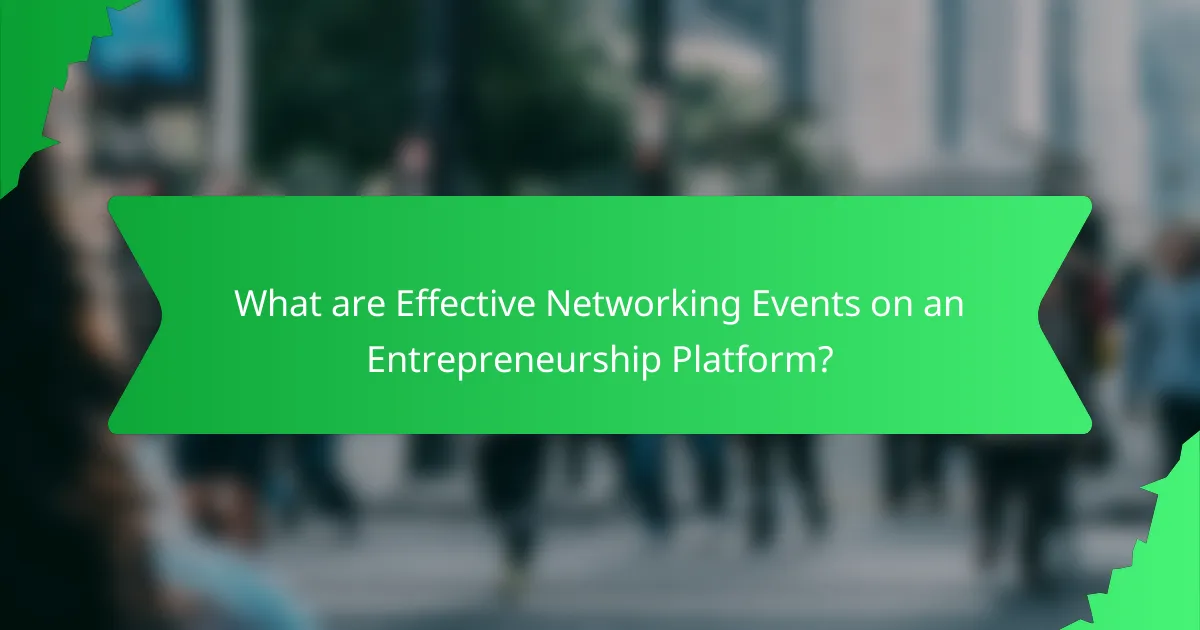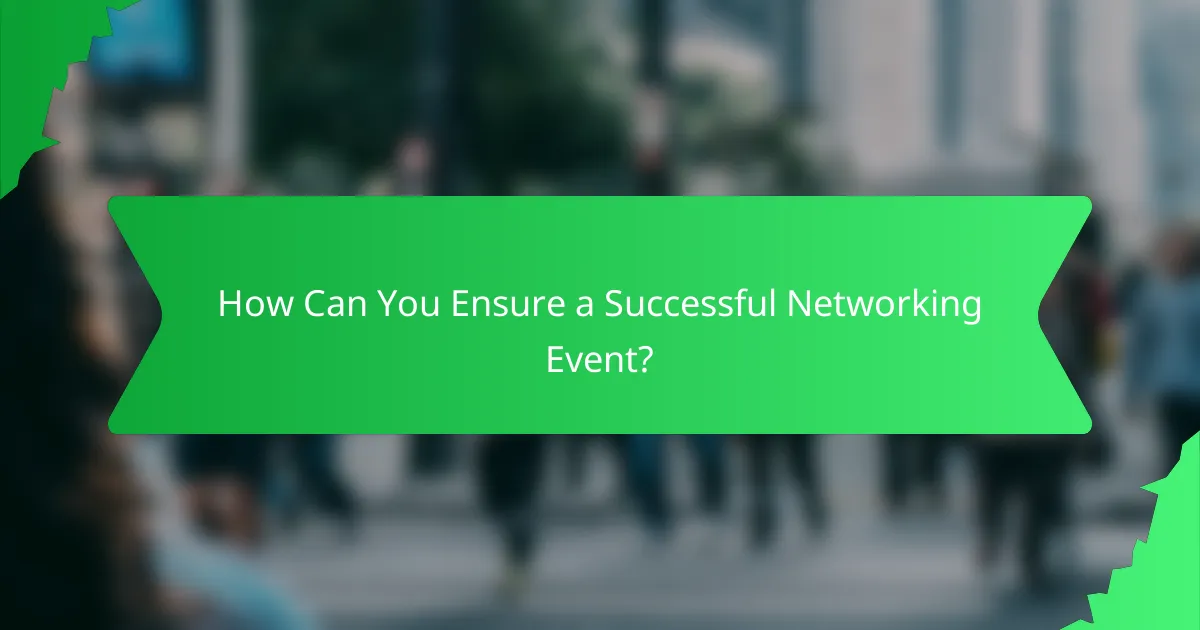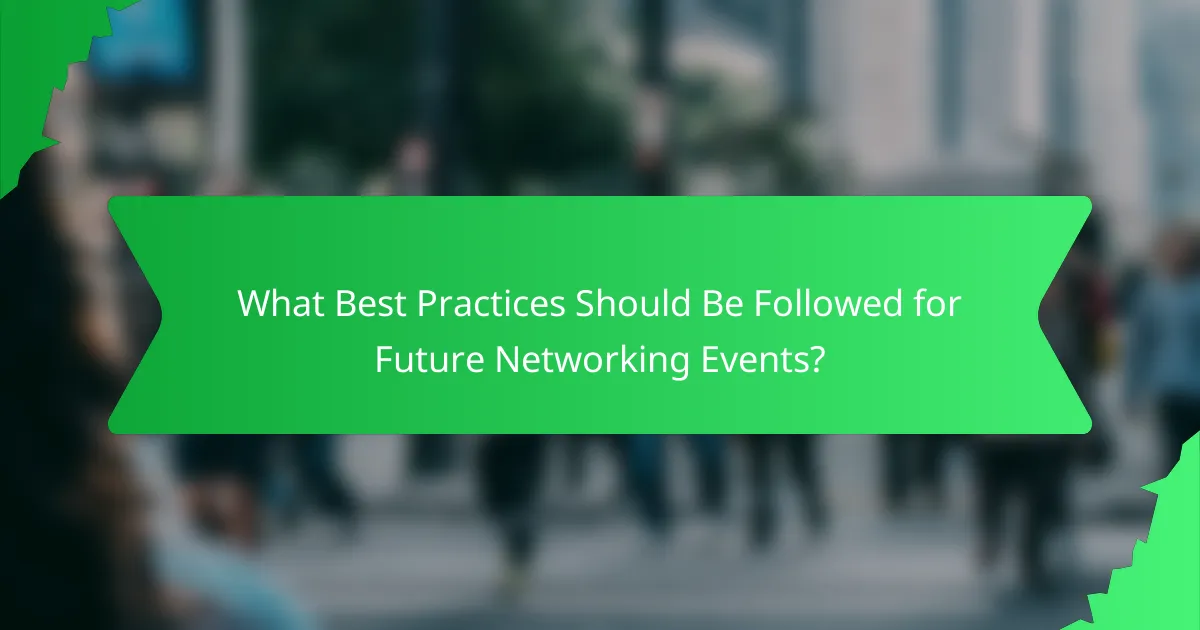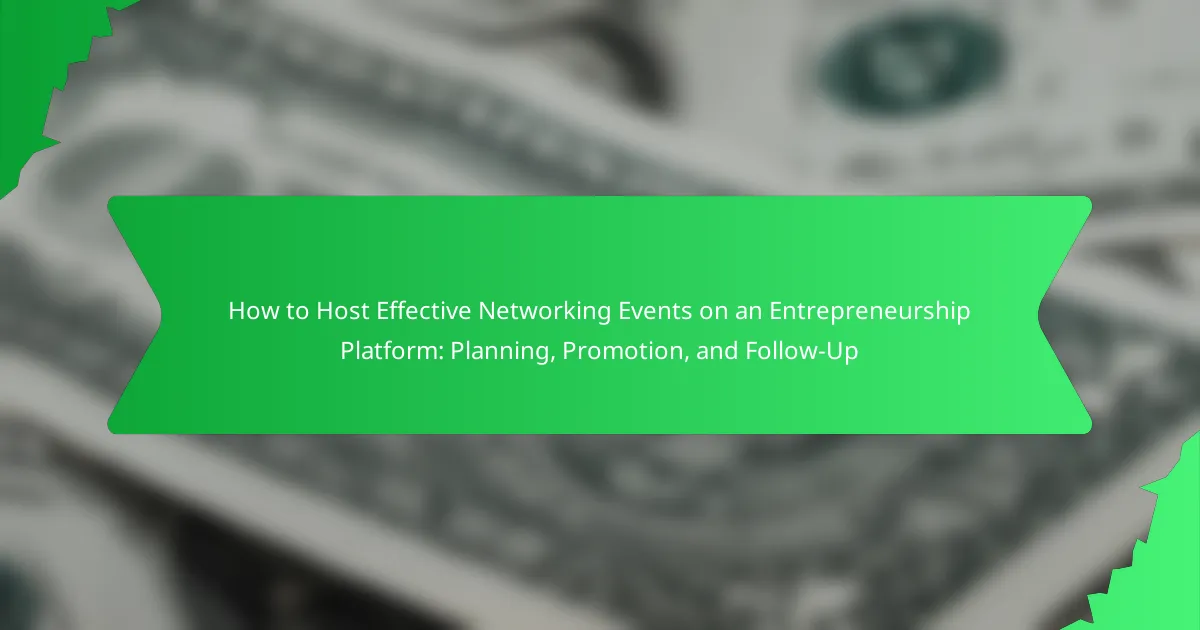Effective networking events on an entrepreneurship platform are structured gatherings that facilitate connections among entrepreneurs through workshops, panel discussions, and pitch sessions. These events are designed to encourage collaboration, idea exchange, and showcase projects, often featuring industry experts as speakers. Key elements for successful networking events include thorough planning, clear objectives, appropriate venues, and effective promotion through social media and email campaigns. Engaging activities and structured networking opportunities enhance interaction among attendees, while post-event feedback is crucial for continuous improvement. Future events should prioritize tailored agendas, interactive elements, and technology to expand reach and inclusivity.

What are Effective Networking Events on an Entrepreneurship Platform?
Effective networking events on an entrepreneurship platform are structured gatherings designed to foster connections among entrepreneurs. These events often include workshops, panel discussions, and pitch sessions. They encourage collaboration and idea exchange. Successful networking events typically feature industry experts as speakers. They also provide opportunities for attendees to showcase their projects. Engaging activities and breakout sessions enhance interaction. Networking events should be promoted through social media and email campaigns. Data shows that 85% of jobs are filled through networking, highlighting their importance.
How do Networking Events Foster Entrepreneurial Connections?
Networking events foster entrepreneurial connections by providing a structured environment for interaction. These events bring together diverse individuals, including entrepreneurs, investors, and industry experts. Participants can share ideas, resources, and experiences. This exchange enhances collaboration opportunities. According to research by the Kauffman Foundation, 70% of entrepreneurs find new partners or investors at networking events. The informal setting encourages relationship building and trust. Networking events also facilitate access to valuable information and mentorship. Overall, they serve as a catalyst for business growth and innovation.
What types of connections can entrepreneurs make at these events?
Entrepreneurs can make various types of connections at networking events. They can connect with potential investors who are looking to fund innovative ideas. Entrepreneurs can also meet fellow entrepreneurs to share experiences and collaborate on projects. Additionally, they can network with industry experts for mentorship and guidance. Connections with service providers, such as marketing or legal experts, can also be formed. These relationships can lead to partnerships that enhance business operations. According to a 2022 survey by the Kauffman Foundation, 70% of entrepreneurs attribute their success to networking opportunities. This highlights the significance of making diverse connections at such events.
How do these connections impact entrepreneurial success?
Connections significantly impact entrepreneurial success by enhancing access to resources and opportunities. Networking facilitates relationships with potential investors, partners, and customers. These relationships can lead to funding opportunities, strategic alliances, and market insights. According to a study published in the Journal of Business Venturing, 70% of entrepreneurs attribute their success to networking. Additionally, networking helps entrepreneurs gain mentorship and guidance, which can be crucial in navigating challenges. Overall, strong connections provide a competitive advantage in the entrepreneurial landscape.
Why is Planning Crucial for Successful Networking Events?
Planning is crucial for successful networking events because it ensures that all elements are organized and aligned with the event’s goals. Effective planning helps in selecting the right venue, which can accommodate the expected number of attendees comfortably. It also allows for the identification of key speakers or facilitators who can engage the audience effectively.
Additionally, a well-structured plan includes a timeline for marketing and promotion, which is essential for maximizing attendance. Statistics show that events with a clear promotional strategy see up to 50% higher participation rates.
Moreover, planning facilitates the creation of a structured agenda that encourages networking opportunities among participants. This structure helps attendees feel more comfortable and engaged, leading to meaningful connections.
In summary, thorough planning directly impacts the quality and effectiveness of networking events, ultimately determining their success.
What key elements should be considered during the planning phase?
Key elements to consider during the planning phase include defining objectives, identifying target audience, and selecting a suitable venue. Objectives should be specific, measurable, achievable, relevant, and time-bound (SMART). Understanding the target audience helps tailor the event to their needs and preferences. Venue selection involves considering capacity, accessibility, and facilities. Budgeting is crucial to ensure all expenses are accounted for. Developing a timeline ensures that all tasks are completed on schedule. Lastly, creating a marketing strategy is essential for promoting the event effectively. Each of these elements contributes to the overall success of the networking event.
How can the target audience influence event planning?
The target audience significantly influences event planning by dictating preferences and expectations. Understanding their demographics helps tailor the event’s content and format. For instance, younger audiences may prefer interactive sessions, while professionals might favor panel discussions. Feedback from potential attendees can guide the choice of speakers and topics. Surveys and polls can provide insights into their interests and availability. This data-driven approach leads to higher engagement and satisfaction. Events designed with the audience in mind report increased attendance and positive feedback. Ultimately, aligning the event with audience needs enhances its overall success.
What Role Does Promotion Play in Networking Events?
Promotion is essential in networking events as it drives attendance and engagement. Effective promotion increases visibility and attracts a diverse audience. Utilizing various channels such as social media, email newsletters, and partnerships enhances outreach. Research indicates that well-promoted events see up to 50% higher attendance rates. Promotion also sets the tone and expectations for the event. It helps convey the value proposition to potential attendees. Additionally, strong promotional efforts can lead to greater sponsorship opportunities. Overall, promotion is a key factor in the success of networking events.
Which promotional strategies are most effective for reaching entrepreneurs?
Content marketing is the most effective promotional strategy for reaching entrepreneurs. This approach focuses on creating valuable content that addresses the needs and interests of entrepreneurs. According to a survey by the Content Marketing Institute, 70% of marketers actively invest in content marketing. Social media marketing is also highly effective, with platforms like LinkedIn being particularly popular among entrepreneurs. Research indicates that 80% of entrepreneurs use social media to connect with peers and find resources. Email marketing remains a strong strategy, as 73% of millennials prefer email for business communication. Networking events and webinars can also effectively engage entrepreneurs, as they facilitate direct interaction and relationship building.
How can social media be leveraged for event promotion?
Social media can be leveraged for event promotion by creating targeted campaigns and engaging content. Platforms like Facebook, Instagram, and Twitter allow for precise audience targeting. Event pages can be created to provide details and updates. Engaging visuals and videos can capture attention and generate interest. Hashtags can increase visibility and encourage user-generated content. Influencer partnerships can extend reach to broader audiences. Paid advertising can enhance visibility among potential attendees. Analytics tools can measure engagement and optimize strategies. According to a study by Eventbrite, 93% of event creators use social media for promotion, highlighting its effectiveness.

How Can You Ensure a Successful Networking Event?
To ensure a successful networking event, focus on thorough planning and engagement strategies. Identify clear objectives for the event. This sets a foundation for all activities. Choose an appropriate venue that encourages interaction. A comfortable space facilitates networking. Promote the event effectively through multiple channels. Use social media, email, and community boards to reach your audience. Create an agenda that includes structured networking opportunities. This can include icebreakers or discussion groups. Encourage attendees to prepare their introductions in advance. This helps streamline conversations. Collect feedback after the event to improve future gatherings. Feedback provides insights into what worked and what didn’t.
What Steps Should You Take in the Planning Process?
Identify the objectives of the networking event. Clear goals guide the planning process. Determine the target audience for tailored content and engagement. Choose a suitable date and time to maximize attendance. Select an appropriate venue that accommodates the expected number of participants. Develop a budget that covers all necessary expenses, including venue, catering, and marketing. Create an agenda that outlines the event flow and key activities. Promote the event through various channels to reach the target audience effectively.
How do you set clear objectives for the event?
Set clear objectives for the event by defining specific, measurable goals. Identify the purpose of the event, such as networking, education, or collaboration. Ensure objectives align with the overall vision of the entrepreneurship platform. Use the SMART criteria: Specific, Measurable, Achievable, Relevant, and Time-bound. For example, aim to connect 50 entrepreneurs within two hours. Communicate these objectives to all stakeholders involved. This clarity helps in measuring success post-event. Studies show that events with defined objectives are 30% more likely to meet their goals.
What logistical considerations are essential for event success?
Essential logistical considerations for event success include venue selection, scheduling, and resource allocation. The venue must accommodate the expected number of attendees and provide necessary facilities. Scheduling should consider participants’ availability to maximize attendance. Resource allocation involves budgeting for materials, catering, and technology needs. Effective transportation and parking options enhance accessibility. Clear communication regarding event details is crucial for attendee preparedness. Lastly, contingency planning for unforeseen circumstances ensures smooth execution. These factors significantly influence overall event effectiveness and attendee satisfaction.
How Can You Engage Attendees During the Event?
Engaging attendees during an event can be achieved through interactive activities. Incorporate live polls and Q&A sessions to encourage participation. Use technology like event apps to facilitate networking among attendees. Organize breakout sessions for smaller group discussions, fostering deeper connections. Provide opportunities for attendees to share their experiences and insights. Implement gamification elements to make learning enjoyable and competitive. Schedule networking breaks to allow informal interactions. These strategies can enhance attendee involvement and satisfaction.
What interactive activities can enhance networking opportunities?
Interactive activities that can enhance networking opportunities include icebreaker games, panel discussions, and workshops. Icebreaker games encourage participants to engage and share information about themselves. These activities foster connections and create a comfortable environment for networking. Panel discussions provide insights from industry experts and facilitate audience interaction. Workshops allow attendees to collaborate on projects, enhancing relationship-building. Additionally, speed networking sessions enable quick, focused conversations, maximizing connections. Research shows that interactive formats increase participant engagement and satisfaction at networking events. According to a study by the Event Marketing Institute, 95% of event attendees find networking opportunities valuable.
How can you create a welcoming environment for participants?
To create a welcoming environment for participants, ensure that the venue is inviting and accessible. Use clear signage to guide attendees. Provide comfortable seating arrangements to facilitate conversation. Offer refreshments to create a relaxed atmosphere. Greet participants warmly upon arrival to make them feel valued. Encourage introductions among attendees to foster connections. Utilize inclusive language in all communications to promote diversity. Implement feedback mechanisms to continuously improve the environment based on participant experiences.
What Follow-Up Strategies Should Be Implemented Post-Event?
Send personalized thank-you emails to all attendees. This fosters goodwill and strengthens relationships. Include a recap of key highlights from the event. Sharing insights reinforces the value of their participation. Create a feedback survey to gather attendee opinions. This data helps improve future events. Share recorded sessions or materials from the event. Providing access to resources enhances the experience. Connect attendees through a dedicated online group. This encourages ongoing networking and collaboration. Follow up with leads generated during the event. Timely outreach can convert interest into opportunities.
How can you maintain connections made during the event?
To maintain connections made during the event, follow up with attendees promptly. Send personalized emails or messages within 48 hours. Reference specific conversations to jog their memory. Connect on professional networking platforms like LinkedIn. Share valuable resources or insights discussed during the event. Schedule one-on-one meetings to deepen relationships. Engage with their content on social media to stay connected. Regularly check in to nurture the relationship over time. Research shows that timely follow-ups increase the likelihood of lasting connections.
What tools can assist in effective post-event communication?
Email marketing platforms assist in effective post-event communication. These tools enable organizers to send personalized follow-up messages to attendees. Examples include Mailchimp and Constant Contact. They provide templates and analytics to track engagement. Social media management tools also play a crucial role. Platforms like Hootsuite or Buffer help in sharing event highlights. They facilitate interaction with attendees post-event. Survey tools like SurveyMonkey gather feedback efficiently. Collecting insights enhances future event planning. Collaboration tools such as Slack or Microsoft Teams keep teams informed. They streamline communication among organizers after the event.

What Best Practices Should Be Followed for Future Networking Events?
Future networking events should prioritize clear objectives and tailored agendas. Establishing specific goals helps focus the event and measure success. Engaging speakers and relevant topics enhance attendee interest. Incorporating interactive elements fosters connections among participants. Setting a conducive environment encourages open communication. Utilizing technology for virtual attendance expands reach and inclusivity. Collecting feedback post-event informs improvements for future gatherings. Research shows that 70% of attendees value networking opportunities, making these practices essential for success.
How Can You Evaluate the Success of Your Networking Event?
To evaluate the success of your networking event, measure attendee satisfaction, engagement, and outcomes. Collect post-event surveys to gauge participant feedback on organization and value. Analyze the number of meaningful connections made during the event. Track follow-up interactions and partnerships formed as a result. Review social media engagement metrics related to the event. Compare attendance numbers against your goals and previous events. Assess the quality of speakers or content presented. These metrics provide a comprehensive view of the event’s effectiveness.
What metrics should be considered for measuring success?
Key metrics for measuring success in networking events include attendee engagement, conversion rates, and feedback scores. Attendee engagement can be assessed through participation rates and the number of connections made. Conversion rates reflect how many attendees become leads or customers post-event. Feedback scores gauge attendee satisfaction and areas for improvement. Tracking social media mentions and interactions also provides insight into event reach and impact. A study by Eventbrite found that 70% of event organizers consider attendee satisfaction as a primary measure of success.
How can feedback from attendees improve future events?
Feedback from attendees can significantly enhance future events. It provides insights into attendee satisfaction and areas needing improvement. Specific feedback helps organizers understand what worked well and what did not. For example, a survey may reveal that participants enjoyed networking sessions but found workshops too lengthy. This information allows organizers to adjust the format for future events. Additionally, attendee suggestions can introduce new ideas or topics that resonate with the audience. By implementing feedback, organizers can increase engagement and attendee retention. Research shows that events that adapt based on feedback see a 20% increase in repeat attendance.
What Common Challenges Do Event Hosts Face and How Can They Be Overcome?
Event hosts commonly face challenges such as venue selection, budget constraints, and attendee engagement. Venue selection can be difficult due to availability and suitability for the event type. Budget constraints often limit resources for marketing and logistics. Attendee engagement is crucial for event success and can be challenging to maintain.
To overcome venue selection issues, hosts should start planning early and consider multiple options. They can use online platforms to compare venues and read reviews. Budget constraints can be managed by creating a detailed budget and prioritizing essential expenses. Hosts can seek sponsorships or partnerships to alleviate financial pressure.
Engagement can be enhanced by incorporating interactive elements such as Q&A sessions, networking activities, and feedback opportunities. Utilizing social media for promotion can also increase visibility and attract more attendees. By addressing these challenges proactively, event hosts can improve the overall success of their networking events.
How can you address low attendance rates effectively?
To address low attendance rates effectively, analyze the reasons behind the low turnout. Conduct surveys to gather feedback from past attendees and potential participants. Identify barriers such as scheduling conflicts, lack of interest, or insufficient promotion. Implement targeted marketing strategies to increase awareness. Use social media, email campaigns, and partnerships to reach a wider audience. Offer incentives like refreshments or networking opportunities to attract attendees. Monitor attendance patterns and adjust future event planning accordingly. According to Eventbrite’s 2020 research, events with clear value propositions see a 20% increase in attendance.
What strategies can mitigate networking event-related anxiety among attendees?
To mitigate networking event-related anxiety among attendees, several strategies can be implemented. Preparation is key; attendees should research participants and topics beforehand. Practicing introductions can boost confidence. Setting realistic expectations about outcomes can reduce pressure. Creating a welcoming environment encourages open communication. Icebreaker activities can facilitate initial interactions. Providing clear event agendas helps attendees know what to expect. Additionally, offering support resources, such as mentors or facilitators, can ease anxiety. These strategies have been shown to improve attendee comfort and engagement at networking events.
What Tips Can Enhance Your Networking Event Experience?
Engaging actively with attendees enhances your networking event experience. Start by preparing an elevator pitch to introduce yourself succinctly. Approach participants with genuine interest and ask open-ended questions. This encourages dialogue and builds rapport. Utilize social media to connect before and after the event. Follow up with new contacts within 48 hours to reinforce connections. Attend workshops or panels to gain insights and meet like-minded individuals. Research attendees and speakers beforehand to identify potential connections. Lastly, maintain a positive attitude; enthusiasm attracts others.
The main entity of the article is effective networking events on an entrepreneurship platform. The article provides a comprehensive overview of the essential components for hosting successful networking events, including planning strategies, promotional techniques, and follow-up methods. It emphasizes the importance of structured environments for fostering entrepreneurial connections, highlights key logistical considerations, and explores effective engagement tactics during events. Additionally, it covers how to evaluate success through attendee feedback and metrics, ensuring continuous improvement for future gatherings.
